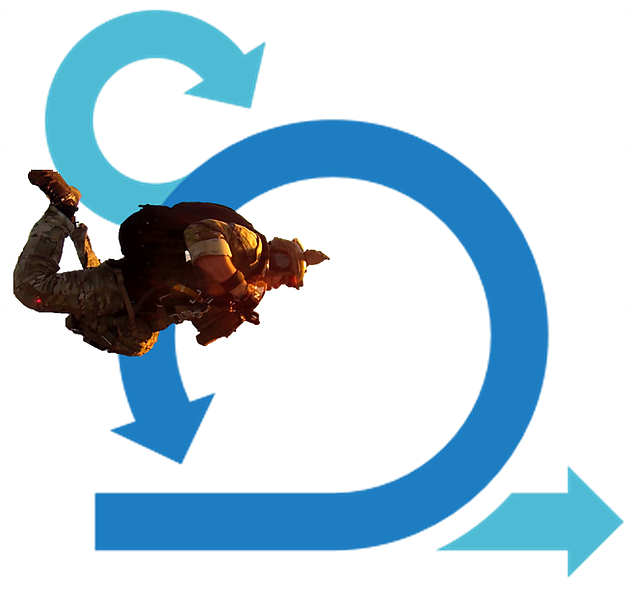

Projects are generally defined as temporary endeavors undertaken to deliver unique products, goods, services, capabilities, or results. This is the same definition as missions and mission-preparation exercises in the military. This means military Members and Veterans with experience planning, resourcing, leading, controlling, and briefing military missions and exercises are experienced project managers, i.e. they are “Veteran Project Managers”. Project management is military Veterans’ secondary informal military occupation!
Some projects that have a clear scope, like build a building, can be delivered using a predictive lifecycle, i.e. we plan a lot of it up front, then deliver it. Planning and executing projects in this approach is called ‘predictive’ in the Agile Practice Guide recently produced jointly by PMI and the Agile Alliance (2017).
Other projects that have fuzzy scopes or high-risk benefit from consistent, constant cycles of planning a bit, doing a bit, receiving feedback on the bits done, and incorporating that customer feedback into future bits. Since the customer doesn’t know exactly what they want or need, we’ll build prototypes, sketches, drawings, sand tables, or products they can look at and provide feedback on throughout the development lifecycle, which saves rework, scrap, time, cost, and resources. These projects are said to benefit from an ‘agile’ approach.
Projects like that last IG inspection you had, or that last slide deck you built for your commander, or that last patrol or sortie you conducted; are agile! You had a general idea of intent, but fleshed out the plan and the deliverables as you met the milestones by soliciting customer/commander feedback often. This means that Veteran Project Managers are agile project managers too, i.e. while project management is military Veterans’ secondary informal military occupation; most do it agilely!
They must! Veteran Project Managers are agile; they don’t focus on doing agile. In fact, the agile and project management languages may be foreign to them. However, as a military Veteran and project manager, here are the Top 10 Reasons I consider Veteran Project Managers Agilists! I didn’t make it up either! This content is derived directly from the Agile Practice Guide!
1. They lead “high-uncertainty projects [that] have high rates of change, complexity, and risks” (Agile Practice Guide, 2017). These types of projects necessitate short cycles with consistent, constant feedback to the team, so it can quickly adapt to changing requirements.
2. They create project plans, but they value responsiveness to change over the plan, which is one of the four values of the Agile Manifesto.
3. Their highest priority is customer satisfaction; failing commander’s intent is not an option. This is one of the twelve principles behind the Agile Manifesto.
4. Missions are built around motivated individuals; one of the twelve Agile Manifesto principles.
5. A constant pace of progress is sustained indefinitely until project completion; principle.
6. Attention to technical excellence and good project design is continuous; principle.
7. The team reflects on how to become more effective after every iteration, and tunes is behavior accordingly.
8. They practice ‘servant leadership’, “focusing on understanding and addressing the needs and development of team members in order to enable the highest possible team performance” (Agile Practice Guide, 2017). Furthermore, they define the ‘why’ so the team can coalesce around the project goal, they coach each team member to contribute to the work and the success, they look for and value results over perfect process adherence, they build communication and coordination within the team and the organization, using interactive meetings, informal dialog, and knowledge sharing; practice.
9. They use many agile practices, and have for years; such as: frequent retrospectives, i.e. meetings to reflect on how to become more effective by generating lessons learned for use in the next iteration. These are called After Action Reviews (AARs) or Hot Washes depending on the service member’s Service; identify and order work to accomplish using a backlog; and daily standups, called formations or musters in uniform;
10. They are lean thinkers, delivering value is paramount, respect for people is key, waste is minimized, change is adapted to, and continuous improvement is baked into the way they operate.
Eric is a decorated 2-Service, 2-Era Military Veteran; Serial Founder of 3 companies; an experienced, credentialed project manager and PMI-Chapter recognized mentor; and an “entertaining” instructor/public speaker on project management, deep learning and the military transition, PMI’s PMP® and CAPM® exams; Vetrepreneurship; and on project manager development. He helps Military Veterans change their lives profoundly through project management, entrepreneurship, and AI through inspiration, translation, training, and placement. For more information, please visit https://vets2pm.com, www.militaryvetstone.com, and www.linkedin.com/in/docwright2012.
PMBOK® Guide, PMP®, and CAPM® are registered marks of the Project Management Institute, Inc.